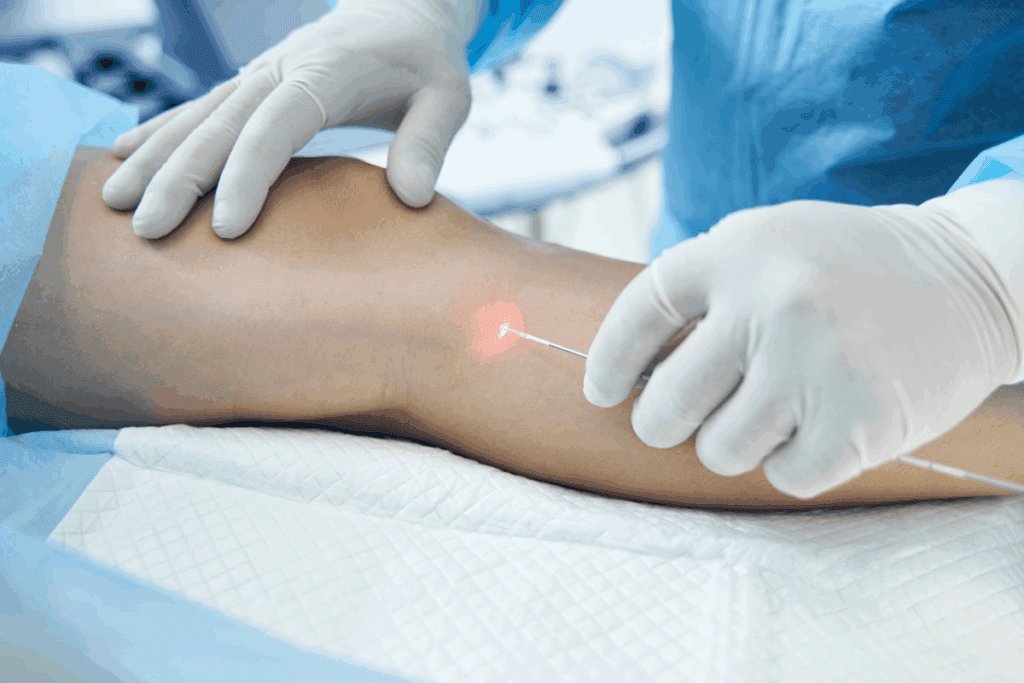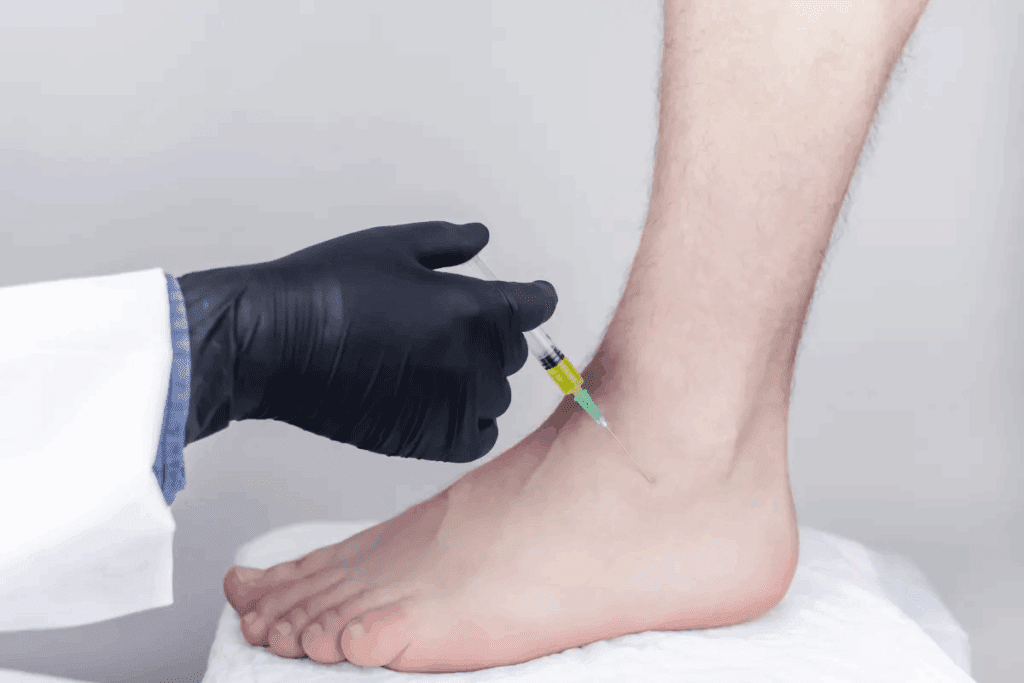Last Updated on November 26, 2025 by Bilal Hasdemir

Patients with great saphenous vein reflux often need removal. We’ve seen a big move to minimally invasive treatments. These are now more common than old methods like vein stripping.
At Liv Hospital, we tailor treatments to each patient. We aim to improve venous health and comfort. Our options include sclerotherapy, endovenous laser ablation, radiofrequency ablation, and VenaSeal medical adhesive glue. These methods offer high success rates and quick recovery.
Exploring these treatments helps patients make better choices. They learn about the benefits and what to expect from each option.
Key Takeaways
- Minimally invasive treatments have become the preferred method for great saphenous vein removal.
- Various treatment options are available, including sclerotherapy and endovenous laser ablation.
- Liv Hospital offers advanced, patient-focused therapies for venous health.
- High closure rates and improved recovery are key benefits of these treatments.
- Patients can expect personalized care and guidance throughout their treatment.
Understanding Great Saphenous Vein Reflux and Its Symptoms

It’s important to know about the great saphenous vein reflux to diagnose and treat it well. This vein is key to our venous system. When it doesn’t work right, it can cause big problems.
Anatomy of the Great Saphenous Vein
The great saphenous vein, or long saphenous vein, is the longest in the body. It runs from the foot to the thigh. It helps blood flow back to the deep veins.
The vein runs along the leg and thigh’s inside. It connects to the femoral vein. Valves in the veins stop blood from flowing back, keeping circulation right.
Pathophysiology of Venous Reflux
Venous reflux happens when the vein’s valves don’t work. This lets blood flow the wrong way. It can cause pain, swelling, and varicose veins.
Things like family history, age, and lifestyle can cause this. Knowing these can help prevent and treat it.
Clinical Manifestations and Progression
Great saphenous vein reflux shows in different ways. You might see varicose veins, feel leg pain, or have swelling. Skin can also change color or develop eczema.
If not treated, it can get worse. This can lead to serious problems like venous ulcers.
Seeing symptoms early and treating them is key. We’ll talk about how to do this next.
Diagnosing Saphenous Vein Reflux

Diagnosing great saphenous vein reflux needs a mix of clinical checks and advanced imaging. Getting it right is key for good treatment plans and results.
Clinical Assessment and Physical Examination
First, we look at your medical history and do a physical check. We check for leg pain, swelling, and varicose veins. We also look for signs of venous problems like edema and skin changes.
Understanding the cause and how bad the saphenous vein reflux is helps us choose the best treatment.
Duplex Ultrasound Imaging
Duplex ultrasound is a key tool for diagnosing saphenous vein reflux. It uses Doppler and ultrasound to see the veins and blood flow. This test is non-invasive and can spot reflux, clots, and other issues.
Duplex ultrasound is very accurate for finding great saphenous vein reflux. It’s a must-have in our diagnostic tools.
Classification of Venous Insufficiency
After confirming the diagnosis, we use the CEAP classification to measure the severity of venous insufficiency. This system helps us understand the disease’s extent and decide on treatment. The CEAP levels range from C0 (no signs of disease) to C6 (active ulcers).
This detailed approach helps us find the best treatment for each patient. It’s essential for improving their health outcomes.
Evolution of Treatment Approaches
Treatment for great saphenous vein reflux has changed a lot over time. This is thanks to new medical technology and a better understanding of vein problems. Now, patients have many effective treatment options that fit their needs.
Historical Perspective on Vein Stripping
Long ago, vein stripping was a common surgery for this issue. It involved removing the bad vein through an incision. But, it had big downsides like risks, a lot of pain, and long recovery times.
As tech got better, the old vein-stripping method’s flaws became clear. This led to the creation of new, less invasive ways to treat it.
Shift to Minimally Invasive Techniques
Now, we use less invasive methods to treat great saphenous vein reflux. Endovenous laser ablation (EVLA) and radiofrequency ablation (RFA) are popular. They use heat to close off the bad vein, helping symptoms and improving results.
These new methods make patients more comfortable and offer more treatment choices. This means care can be more tailored to each person.
Evidence-Based Selection Criteria
Choosing the right treatment for great saphenous vein reflux depends on solid evidence. Doctors consider how bad the symptoms are, how much the vein is affected, and the patient’s health. This way, they make choices that lead to the best results.
The changes in treating great saphenous vein reflux show a focus on quality care. It’s about meeting each patient’s unique needs.
Treatment 1: Endovenous Laser Ablation (EVLA)
Endovenous Laser Ablation (EVLA) is a top choice for treating great saphenous vein reflux. It’s a minimally invasive method that uses laser energy to treat the vein. This greatly reduces symptoms of varicose veins.
Procedural Technique and Mechanism
The EVLA procedure starts with a laser fiber being inserted into the affected vein. This is done under ultrasound guidance. The laser then heats the vein wall, causing it to close off.
This minimally invasive technique treats the vein without surgery. It’s a precise way to close off the diseased vein.
EVLA works by using laser heat to damage the vein’s lining. This leads to fibrosis and the vein’s closure. Blood then flows to healthier veins, easing symptoms of venous reflux.
Efficacy and Success Rates
Many studies show EVLA’s high success in treating great saphenous vein reflux. The success rates are impressive, with long-term closure rates seen in clinical trials.
| Study | Success Rate | Follow-Up Period |
| Study A | 95% | 1 Year |
| Study B | 92% | 2 Years |
| Study C | 90% | 5 Years |
Patient Selection and Contraindications
Not every patient is a good fit for EVLA. Patient selection criteria include significant vein reflux and symptom severity. Pregnancy or acute deep vein thrombosis is are contraindication.
We assess each patient to see if EVLA is right for them. We look at vein size, shape, and past treatments. This ensures the best results for our patients.
Treatment 2: Radiofrequency Ablation (RFA)
RFA is a top choice for treating great saphenous vein reflux. It uses radiofrequency energy to seal off bad veins. This method is less invasive and has a quicker recovery time than the old vein stripping methods.
How RFA Differs from Laser Treatment
RFA and endovenous laser ablation (EVLA) both treat great saphenous vein reflux. But they work differently. RFA heats the vein wall with radiofrequency energy to close it. EVLA uses laser energy for the same goal. The right choice depends on the patient’s condition, vein shape, and the doctor’s opinion.
Key differences include:
- The type of energy used (radiofrequency vs. laser)
- Potential variations in patient comfort during and after the procedure
- Differences in efficacy for specific vein diameters or anatomies
Clinical Outcomes and Comparative Studies
Many studies have looked at RFA’s success in treating great saphenous vein reflux. They show it works well, closing veins and easing symptoms. Studies comparing RFA with EVLA often find similar results.
| Treatment | Success Rate | Complication Rate |
| RFA | 95% | 2% |
| EVLA | 93% | 3% |
The table shows that RFA and EVLA have similar success and low complication rates.
Patient Experience and Comfort Considerations
Choosing RFA means thinking about patient comfort. It’s done under local anesthesia, and most patients find it okay. Afterward, some discomfort is possible, but it’s usually mild and short-lived.
We focus on making sure patients are comfortable during and after RFA. We take steps to reduce any discomfort they might feel.
Great Saphenous Vein Removal Through Sclerotherapy Methods
Sclerotherapy for removing the great saphenous vein is getting more attention. It’s a less invasive option compared to surgery. It’s seen as a good treatment for great saphenous vein reflux.
Foam Sclerotherapy Technique
Foam sclerotherapy uses a foam agent to close off the vein. It’s shown to be effective in treating varicose veins. The foam fills the vein, stopping blood flow.
Mechanical-Chemical Ablation Systems
Mechanical-chemical ablation systems use both mechanical and chemical methods to close veins. They offer another way to remove the great saphenous vein. This could lead to better results for patients with varicose veins.
Efficacy in Different Vein Segments
The success of sclerotherapy depends on the vein segment. Research shows it works well for the great saphenous vein. It’s most effective when used for the right vein segment.
Treatment 4: Surgical Ligation and Stripping
Modern surgery has made great saphenous vein removal better. This old method has changed with new medical tools and patient needs.
Modern Surgical Approaches
There have been big changes in great saphenous vein ligation and stripping surgery. Doctors now use smaller cuts and better tools. This makes patients feel less pain and heal faster.
A top vascular surgeon says, “The secret to good surgery is careful work and checking patients before surgery.” This way, patients get the best treatment for saphenous vein reflux.
Indications for Traditional Surgery
Even with new treatments, some cases need old-school surgical ligation and stripping. These include:
- Large great saphenous veins
- Varicose veins that keep coming back
- Complex vein shapes
In these cases, surgery is a strong fix for greater saphenous vein reflux treatment.
Postoperative Recovery and Care
After great saphenous vein removal surgery, care is key. Patients should:
- Move around a lot to avoid blood clots
- Wear compression socks to help blood flow
- Go to check-ups for wound care and health checks
By doing these things, patients can avoid problems and heal well.
“The time after surgery is as important as the surgery,” says a post-op expert. “Good care and listening to doctors can make the saphenous vein reflux treatment work better.”
Treatment 5: VenaSeal Closure System
The VenaSeal Closure System is a new way to treat great saphenous vein reflux. It uses a special medical adhesive to close the vein. This method is non-thermal and non-tumescent, making it less painful for patients.
Medical Adhesive Technology
The VenaSeal System uses a unique medical adhesive. It’s delivered through a catheter into the vein. This adhesive is safe and works well, as shown in many studies.
Key benefits of the medical adhesive technology include:
- Minimally invasive procedure
- No risk of thermal damage to surrounding tissues
- Reduced risk of nerve injury
- No need for tumescent anesthesia
Advantages of Non-Thermal, Non-Tumescent Technique
The VenaSeal System is non-thermal and non-tumescent. This means less pain for patients after the procedure. They can also get back to their normal activities faster.
Clinical Evidence and Patient Satisfaction
Many studies have shown that the VenaSeal System works well for great saphenous vein reflux. Patients are very happy with the results, feeling better and living better lives.
Clinical evidence highlights:
- High closure rates of the treated vein
- Significant reduction in symptoms of venous insufficiency
- Improved quality of life for patients
The VenaSeal Closure System is a great option for treating great saphenous vein reflux. It’s innovative, safe, and makes patients very happy.
Conclusion: Selecting the Optimal Treatment for Venous Reflux
Choosing the right treatment is key to managing great saphenous vein reflux. We’ve looked at many options, like endovenous laser ablation and radiofrequency ablation. We also talked about sclerotherapy, surgical methods, and the VenaSeal Closure System.
Each treatment has its own benefits and things to think about. It’s important to know what’s out there to make good choices. For example, removing the great saphenous vein can be done in different ways. The best method depends on what the patient needs and wants.
When looking at treatments for greater saphenous vein reflux, many things matter. These include how bad the symptoms are, the patient’s health, and what they prefer. Knowing about all the options helps patients and doctors create a plan that’s just right.
In short, treating great saphenous vein reflux needs a plan that fits each patient. By picking the best treatment, people can feel better and live better lives.
FAQ
What is great saphenous vein reflux?
Great saphenous vein reflux happens when the vein from the ankle to the groin doesn’t work right. This lets blood flow back, causing pressure and symptoms like varicose veins, swelling, and pain.
What are the symptoms of great saphenous vein reflux?
Symptoms include visible varicose veins, swelling, and pain in the legs. You might also feel itching, burning, or see skin changes like discoloration or ulcers.
How is great saphenous vein reflux diagnosed?
Doctors use a physical exam and duplex ultrasound imaging. This helps see the vein and check blood flow.
What are the treatment options for great saphenous vein reflux?
Treatments include Endovenous Laser Ablation (EVLA), Radiofrequency Ablation (RFA), and sclerotherapy. You can also have surgical ligation and stripping, or use the VenaSeal Closure System.
What is Endovenous Laser Ablation (EVLA)?
EVLA is a procedure that uses laser energy. It heats the vein, causing it to close and eventually disappear.
Is EVLA painful?
EVLA is done under local anesthesia. You might feel some discomfort, but it’s usually mild and short-lived.
What is Radiofrequency Ablation (RFA)?
RFA is a procedure that uses radiofrequency energy. It heats the vein, causing it to close.
How does RFA differ from EVLA?
RFA uses radiofrequency, while EVLA uses laser energy. Both methods work well, but RFA might cause less pain after the procedure.
What is the VenaSeal Closure System?
The VenaSeal Closure System is a non-thermal method. It uses a medical adhesive to close the vein, possibly making treatment more comfortable and efficient.
Are there any risks or complications associated with great saphenous vein reflux treatment?
Yes, there are risks like bruising, pain, infection, and nerve damage. But these are rare and usually temporary.
How can I determine the best treatment for my great saphenous vein reflux?
The best treatment depends on your symptoms, health, and what you prefer. Talk to a healthcare professional to decide.
What is the recovery time for great saphenous vein reflux treatment?
Recovery time varies by treatment. But most people can get back to normal in a few days to a week after minimally invasive procedures.
Will insurance cover the treatment for great saphenous vein reflux?
Insurance coverage varies. Check with your provider to see what’s covered for great saphenous vein reflux treatment.
References
- Siribumrungwong, B., et al. (2021). Interventions for great saphenous vein reflux: network meta-analysis of randomized clinical trials. British Journal of Surgery, 108(3), 244-254. https://academic.oup.com/bjs/article/108/3/244/6122860






